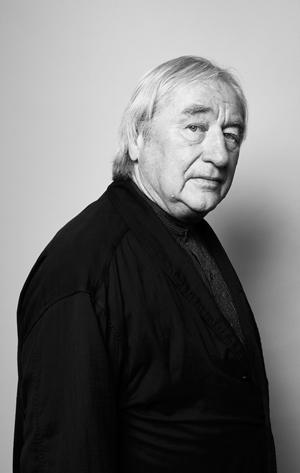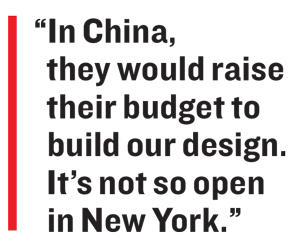Trending
The Closing: Steven Holl
The veteran architect on finally finishing the Hunters Point Library, marrying his student and being liberated in China

Famed architect and watercolorist Steven Holl founded his company as a two-person practice in Chelsea in 1977. The firm has since grown to 40 people across two offices, one around the corner from Hudson Yards and the other in Beijing. Steven Holl Architects has completed more than 60 projects in the U.S., China, Japan and other countries. Holl and his colleagues worked on the $41 million Hunters Point library, which opened in September — nearly a decade after it was designed. Their extension of the John F. Kennedy Center in Washington, D.C., also opened last month, sporting “crinkle concrete” walls, a style of concrete design invented by the firm. The company now has seven projects under construction, eight in design and another nine awaiting approvals or financing. Much of Holl’s work in the U.S. has focused on museums, religious institutions, schools and other public spaces, though his firm has designed a few office towers in China. Holl is also a professor at Columbia University, where he has taught about the phenomenological side of architecture since 1981. The ceiling of his office is lined with boxes containing tens of thousands of his own watercolor paintings, a collection he adds to every day as he works out aspects of his designs.
DOB: December 9, 1947
Lives in: West Village
Hometown: Bremerton, Washington
Family: Married with one daughter
What were you like as a kid? I have a [younger] brother, and he and I built clubhouses in the backyard. At one point, we had an underground clubhouse and a two-story treehouse. I realized later on there are four kinds of architecture: Under the ground, in the ground, on the ground and over the ground. And I think that maybe started with my childhood at 7 years old.
So that’s how you got into architecture? It was an intuitive desire because I could draw, I like mathematics and I like making things. That’s my joy of architecture — being able to make the models, in a way, is enough. You don’t actually have to build every design.
Were either of your parents architects? No. My father had a service heating and sheet metal company. It was putting in furnaces, ductwork and HVAC systems. I actually worked as a sheet metal mechanic when I was 15 and 16. So I always related to the materiality, the machines that would bend and make these complicated geometries. Maybe that was a beginning also.
In college, you studied in London and Rome. What was that like? That was a transforming experience. I lived right behind the Pantheon, so I could go [there] every day and see how the light would come in. In my hometown, there wasn’t really much of any architecture. Seattle was the Space Needle. I went to the World’s Fair opening as a child. But Rome was a depository of amazing ancient spaces.
When you first came to New York from San Francisco, you slept on a board above your office, right? The studio I had was at 655 Sixth Avenue overlooking a Sephardic Jewish cemetery, which is still there. I paid $250 a month for this beautiful cubic space, but there was no hot water. I didn’t have a place to live, so I slept on a plywood shelf over the entrance, and no one knew I lived there. And I went to the YMCA at the end of the day to shower. That was like having a grant — I could teach and support a small practice of two people doing competitions and idealistic work, and the rent was so low. Those were the great days of New York: 1979, 1980, 1981. It was very economical.
 You’ve described that time as helping to shape who you are, but did you view it that way at the time? I was so obsessed with the work that I was just glad to be in New York. I worry about the young people now. They can’t afford to live in New York.
You’ve described that time as helping to shape who you are, but did you view it that way at the time? I was so obsessed with the work that I was just glad to be in New York. I worry about the young people now. They can’t afford to live in New York.
Do you speak any other languages aside from Italian? No. My wife is Greek. My daughter is 3 and a half years old, and she speaks Greek better than me. Her grandmother teaches her every day, so she’s amazing. She translates for me, so if something falls down and she says “épese,” then she turns to me and says “fell down, Baba.”
Your daughter has a Greek name. Was it inspired by mythology? Io Helene Holl. Greek mythology; the moon of Jupiter is also named Io. My mother’s name was Helen, so Helene is Greek. I always said my buildings are my children, and I go back and visit them. But I fell in love, got married. Now I have an actual 3-and-a-half-year-old, which is amazing because her imagination is unparalleled. It makes me stop and rethink the creative impulse and the joy of imagination.
How did you meet your wife, architect Dimitra Tsachrelia? She was my student, and I always bring my most brilliant students into the office, and they work. I have about 10 people that were my former students; some of them have been here as long as 12 years. She was here in 2008. In 2010, I went through a painful divorce and then we got together in 2014. And we got married in 2016.
Where is most of your work located? Most of my built work is in Asia. I have an office now in Beijing. One of the most fortunate things that happened to me was I had work in China when the economy collapsed here in 2008. So other architects were laying people off, and I had so much work in China that I was hiring people.
You won a competition to design the headquarters for the healthcare AI company in Shenzhen. How is working there different? We presented to Wang Jun, the director of iCarbon X, this January, and the foundations are already in the ground. That’s another thing that happens in China that has helped me. In New York and various other places, I can be eight years from the first sketch to the opening of the building. In China, it’s much shorter than that.
Why are the timelines so different? It’s just a different culture altogether. There’s a certain openness for creative ideas — especially when people are doing an important headquarters, or they are trying to make a statement with their architecture. In China, they would raise their budget to build our design. It’s not so open in New York.
What do you think of Hudson Yards? Ah, I’m not going to say anything about it because I can’t say anything positive. I’ll only say this: When there was a competition back in 2000, 2001, whenever it was, we proposed a giant green space plus a suspension over the rail yards. But in the end, nobody won the competition. It was bypassed and went to the highest bidder. So what’s here was purchased by the developer and then controlled by the developer. I think it could’ve been something very positive.
Many of your projects are public spaces. Is that on purpose? It was a conscious decision. I really believe in the public-space contribution of architecture. I’m very proud of this Queens library, which is opening in New York after 10 years of effort. But I couldn’t just do these kinds of buildings; I’d lose money. You need projects like this [motions to model of a tower in China] in order to do projects like the library.
What was the inspiration for the shape of the Hunters Point library? The building could’ve been built on one floor. The site’s big enough for it to be one floor. But we all felt, local City Council member Jimmy Van Bramer especially, that it needed a vertical presence and that it should have views of Manhattan. And it doesn’t have a skin. It’s just textured concrete, marking the things that are going on inside.
What’s the most difficult aspect of working in NYC? I’d say getting the project in the first place. I’ve been here since 1977. [The Hunters Point Library] will be my third thing that I’ve built. It’s a tough city, but I love it. I know I can’t live in Rome; you can’t get anything done. I don’t like Paris because you can’t get a taxi. I lived in London. It smells funny. I thought, the best city is New York.
You live in the West Village, where development is severely restricted. What’s your interest in preservation? I’m not so interested in the historicist part — it’s the sunlight coming to the street. Natural light to me is a psychological gift. All of my buildings have natural light. That’s what we have to be careful of when we build too many tall towers crammed too close together.
What’s your biggest vice? Red wine. Barolo from Piedmont.
— Edited and condensed for clarity.




